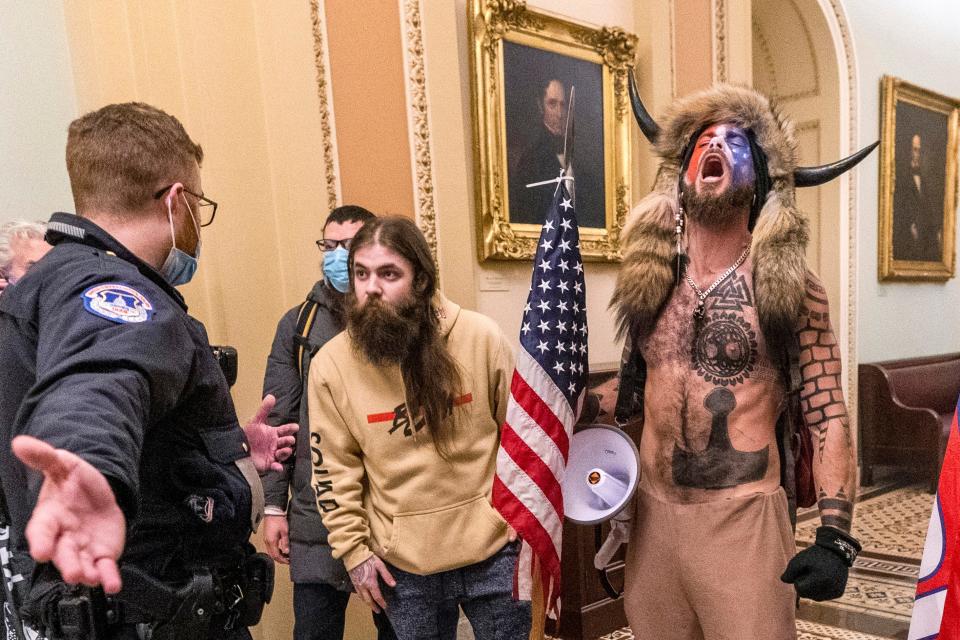5 takeaways from U.S. Capitol security review, including staffing, quick reaction force, K9s
WASHINGTON - Two months after a mob infiltrated the U.S. Capitol, a task force shared its recommendations to significantly improve security at the complex.
The review was conducted by a 16 member-task force, led by retired Army Lt. Gen. Russel Honoré. House Speaker Nancy Pelosi asked him to lead the security review after the Jan. 6 attack on the Capitol that left the nation shaken.
Here are five takeaways from the 15-page report:
U.S. Capitol Police understaffed, lacks sufficient intelligence training
The security review found that U.S. Capitol Police were “understaffed, insufficiently equipped, and inadequately trained to secure the Capitol and members when violently attacked by a large mob.”
USCP’s training for new officers to ensure they’re fully qualified was found to be a “sound system,” however, once on the job, officers cannot easily leave their roles for additional training.
The security review reveals only a “handful” of USCP members have “significant intelligence training.” The Intelligence and Interagency Coordination Division lacks “experiences, knowledge, and processes to provide intelligence support against emerging domestic threats.” The report suggests the intelligence division needs to increase the number of trained analysts to support the Capitol Police’s threat intelligence requirements.
The review also recommends increasing USCP staff to fill all vacancies and reduce overtime hours.
An increase of officers would allow for additional training sessions. And that training curriculum should be upgraded to include modern police tactics and focus on the agency’s shortcomings of collective training.
Capitol Police Board’s decision-making process was too 'slow'
The security review casts some blame on the Capitol Police Board for its slow response to the Jan. 6 attack, which also led to delaying the request for “critical supplemental resources.”
According to the review, the board’s “decision-making process proved too slow and cumbersome to respond to the crisis in January.”
More: 'We all want to know': FBI, Capitol police remain mum on what killed Officer Brian Sicknick
Based on those findings, the security review recommended two U.S. Code revisions. One would allow the U.S. Capitol Police chief to request National Guard and other external law enforcement support without the Capitol Police Board’s preapproval in cases of emergency. The other provides the USCP a way to appeal denied support requests or general lack of action by the board.
Establish a dedicated Quick Reaction Force for Washington
Instead of the nation’s capital having to rely on other law enforcement agencies for support in cases of emergency, the security review recommends that a Quick Reaction Force be established for Washington.
“Our national capital is a prominent tourist destination, venue for many peaceful First Amendment activists, and a high-value target for foreign terrorists or domestic extremists, yet it has no dedicated QRF for response to crises,” the review states.
While recognizing the Mobilized National Guard supplements the USCP, the review calls it a temporary solution, not a permanent one. It is suggested the force would be established from existing law enforcement and be under the command of the D.C. National Guard.

'Explosive Detection Dogs' are 'challenged'
Even the USCP's bomb-sniffing dogs were scrutinized, noting those teams play a key role in comprehensive security.
More: FBI Director Wray: 'Raw' warning about Capitol violence shared multiple times with police
However, the review found the USCP Explosive Detection Dog teams “challenged to meet increasing operational requirements” because of "unfilled positions, non-mission capabale teams and aging dogs." The report recommends filling the current vacancies while also increasing the size of the force in general.
There was also a recommendation for the Capitol Police to hire additional K9 handlers, secure additional dogs for the current vacancies and to replace those where K9 retirements are necessary.
More and better trained officers, mobile fencing are needed
Throughout the security review, additional security measures or improvements to current polices and equipment to the nation’s capital are recommended, including hiring more U.S. Capitol Police officers, offering more training and connecting several cameras and sensor points in the Capitol that were found not to be working.
As the fencing around the Capitol comes down, the security review recommends it be replaced by a mobile fencing options that is “easily erected and deconstructed.” The review also referred to the mobile fencing as “retractable” and able to secure both the Capitol and congressional office buildings.
More: Pentagon evaluates Nat'l Guard staying at Capitol
The mobile fencing would allow an “open campus while giving forces better options to protect the complex and its members should a threat develop,” according to the review.
This article originally appeared on USA TODAY: U.S. Capitol security review: 5 takeaways from the report on Jan. 6

